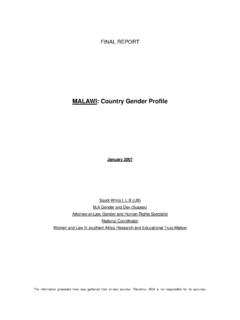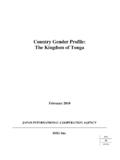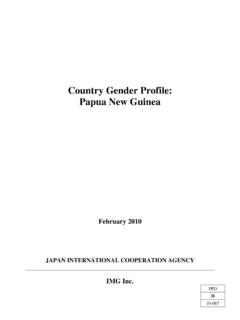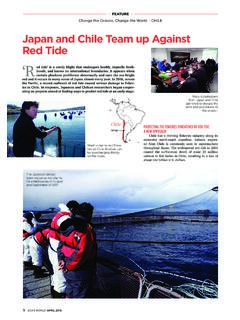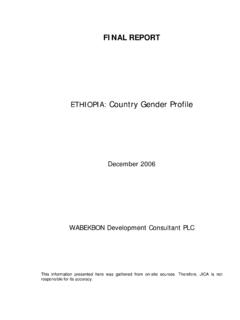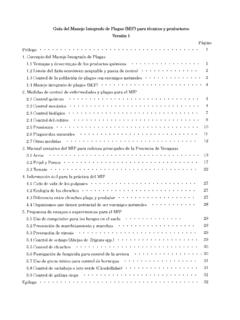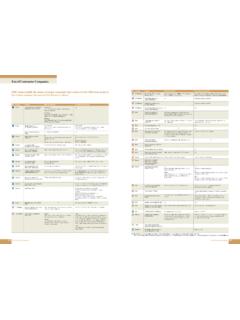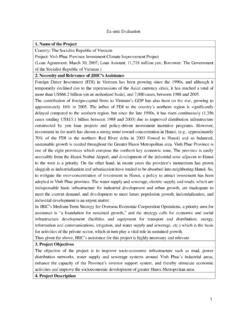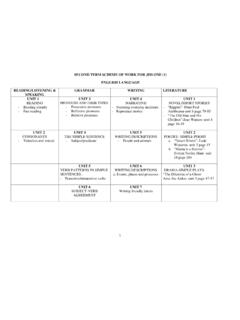Transcription of CHILI PRODUCTION - JICA
1 MOALF/SHEP PLUS. Japan International Cooperation Agency Agriculture and Food Authority Ministry of Agriculture, Livestock and Fisheries Horticultural Crops Directorate State Department for Crop Development & Agricultural Research Smallholder Horticulture Empowerment & Promotion Project for Local and Up-Scaling (SHEP PLUS). Changing Farmers' Mindset from Grow and Sell to Grow to Sell . CHILI PRODUCTION . Presented to the County & AFA (HCD) Staff in charge of the SHEP PLUS Model Farmer Groups during the FT-FaDDE. Prepared by SHEP PLUS. MOALF/SHEP PLUS. 1. introduction : Background CHILI is a member of the Solanaceae family which includes crops such as Potato, Tomato, Black Nightshade and Egg Plant among others CHILI is a plant of tropical and subtropical regions grown for their fleshy fruits Fruits are consumed fresh, dried or in processed form as a table vegetable or spice CHILI produces pungent chemical called capsaicin Scoville scale is used to measure pungency with sweet peppers being mild & Cayenne scorching Fruits are a rich source of Vitamin A & C, B6.
2 Also high in K, Mg, and Fe (AVRDC). 2. MOALF/SHEP PLUS. Common Varieties 1-1 1-2. Photo: Maja Dumat Photo: SHEP PLUS. Source: ne-shop/chilli-seeds/long-slim-cayenne- chilli-seeds/. Long Cayenne African Bird's Eye CHILI . 3. MOALF/SHEP PLUS. Common Varieties Long Cayenne : Plant is tall and highly productive Fruits are long and slim (10cm). The flesh is very thin and very pungent A popular export variety Also suitable for local fresh market and drying African Bird's Eye (ABE) CHILI : Plants are perennials that grow as shrubs (bushy). Fruits are small, clustered, erect, conical and pointed (up to 3cm long). Immature pod color is green, mature color is bright red or purple Fruits are extremely pungent (hot) 4. MOALF/SHEP PLUS. Other Varieties Anaheim Fresno Jalapeno Rocket Short Bullet 5. MOALF/SHEP PLUS.
3 Optimal Ecological Requirements Altitude 0 1,200 metres above sea level Rainfall 600 1,200 mm of rainfall annually Growing 20 30 0C. Temperature Soils Various soil types that are well drained pH range 6. MOALF/SHEP PLUS. 2. G20 technologies Make sure to support farmers carry out G20. techniques for any crop 1. Market survey 7. Incorporating crop 2. Crop planting residues calendar 8. Basal application of 3. Soil testing compost/ manure 4. Composting 9. Recommended 5. Use of quality practices of seedling planting materials preparation/. seedlings from 6. Recommended land registered nursery preparation practices 7. MOALF/SHEP PLUS. 2. G20 technologies and effective spacing use of pesticides of harvesting fertilizer application indices rate post harvest handling water containers weeding addition techniques practices farm records 8.
4 MOALF/SHEP PLUS. Raising Seedlings 3-5. Photo: SHEP PLUS. A transplanted CHILI seedling 9. MOALF/SHEP PLUS. Raising Seedlings (GHCP&PHHT20: Q9). CHILI can be established through the nursery The seed rate is about 75 g/acre Nursery Site Selection: The nursery should be sited in a plot that has not been planted with a member of Solanaceae family for the last 3 years Choose a site with rich, well drained, friable soil Choose an area near a water source and protected from animals 10. MOALF/SHEP PLUS. Raising Seedlings Cont'. Nursery Establishment: Nursery bed: 1 m width by any desired length Till until soil is fine Mix soil with 10 15 kg of potent manure per square meter Sow the seeds cm deep in holes at a spacing of 15 20 cm apart Cover the bed with mulch and water thoroughly 11. MOALF/SHEP PLUS. Raising Seedlings Cont'.
5 Nursery Establishment Cont': Use of seedling trays is recommended, especially for expensive hybrid seeds Seedling trays offer more uniform germination and growth Management of Nursery: Water once a day Where possible, check soil moisture before watering 12. MOALF/SHEP PLUS. Raising Seedlings Cont'. Management of Nursery Cont': As soon as seeds start germinating, remove mulch and create a temporary shade above the seedbed (about 50 %), using shade net or grass mulch Monitor for disease and pests regularly and react accordingly Germination is complete after 1 to 3 weeks Seedlings should be hardened off in the 4th and 5th week after emergence by reducing shade and watering frequency to 3 times per week 13. MOALF/SHEP PLUS. Transplanting Appropriate Time: Seedlings are ready for transplanting 5 6 weeks after emergence (4 6 leaf stage).
6 Transplanting done at the beginning of the rainy season to give seedlings a good start Water nursery beds before lifting the seedlings with a ball of soil around their roots Plant seedlings when temperatures are low Recommended Spacing (GHCP&PHHT20: Q10): Spacing: 60 X 40 cm or 70 X 30 cm are recommended depending on variety Plant population: 16,666-19,000 14. MOALF/SHEP PLUS. Transplanting Cont'. Fertilizer Application Rates (GHCP&PHHT20: Q11): A basic dressing of 100 kg per acre of TSP or DAP depending on soil analysis results Well decomposed manure should be incorporated at a rate of 10 tones per acre Both fertilizer and manure should be well incorporated in the soil before transplanting 15. MOALF/SHEP PLUS. Water Requirement (GHCP&PHHT20: Q12). Plants should be provided with adequate water which is well distributed.
7 Crop irrigation should be considered in areas experiencing rainfall below 600mm/year During fruit development, water stress will lead to fruit and flower abortion 16. MOALF/SHEP PLUS. Top-dressing (GHCP&PHHT20: Q14). Top-dressing can be done first when plants are about 15. cm, then 4 weeks later for the second time 1st top-dressing: In acidic Soils: 40 kg per acre of CAN. In alkaline Soils: 50 kg per acre of SA (Sulphate of Ammonia). Foliar feeds high in magnesium are desirable on alkaline soils 2nd top-dressing: 80 kg per acre of CAN or SA. Note: Type of fertilizer and application rate will depend on results of soil analysis 17. MOALF/SHEP PLUS. Pests & Diseases Control: (GHCP&PHHT20: Q15 & 16). Major Pests A. False Coddling Moth B. Aphid C. Cutworm D. Thrips E. Red Spider Mite F. Root-knot Nematode 18.
8 MOALF/SHEP PLUS. : False Codling Moth 3-13a 3-13b Photos: Marja van der Straten, NVWA Plant Protection Service, (CC BY-NC US). Adult and larva of false codling moth 19. MOALF/SHEP PLUS. : False Codling Moth Identification: The adult is nocturnal and attracted to light When full grown, the larva descends to the ground on a silken thread and spins a tough silken cocoon in the soil or amongst debris. Symptoms: On fruits, the young larvae mines just beneath the surface, or bores into the pith causing premature ripening of the fruits 20. MOALF/SHEP PLUS. : False Codling Moth Control: 3-13. Use of Pheromone Trap Sanitation, crop rotation with non-host crops such as beans, carrots Destruction of wild and cultivated hosts Control of weeds Note: use of trap crops sorghum has shown promise as a trap crop against the Photo: SHEP PLUS.
9 Pest in cotton 21. MOALF/SHEP PLUS. : Aphid 3-14. Photo: Whitney Cranshaw, Colorado State University, (CC BY US). Aphids on a leaf 22. MOALF/SHEP PLUS. : Aphid Identification: Aphids are soft-bodied insects that cluster in shaded areas on the leaves, stems and blossoms Winged aphids move from field to field spreading viral diseases Symptoms: Sticky honey dew Feeding injury in the form of curling leaf margins, yellow spots & leaf distortion 23. MOALF/SHEP PLUS. : Aphid Cont'. Symptoms Cont': Leaf drop if infestation is severe Low PRODUCTION and sun scald of fruit Stained fruits with Aphid excreta Control: Introduce natural enemies, such as Ladybird Beetle, parasitic wasps such as Aphidius transcaspinus ( APHITECH ). Spray with insecticides, such as Acetamiprid (PRESENTO. 200 SP ), Thiacloprid 480 g/L (CALYPSO SC 480 ).
10 24. MOALF/SHEP PLUS. : Cutworm 3-15. Photo: By Neil Phillips from uk (Large Yellow Underwing caterpiller) [CC BY ( )], via Wikimedia Commons :Neil_Phillips_-_Large_Yellow_Underwing_ caterpiller_(by).jpg Cutworm larva 25. MOALF/SHEP PLUS. : Cutworm Identification: Many species of cutworm exist They are grey, brown or black soft-bodied, smooth larva of a large family of moths They curl-up tightly when disturbed They feed at night Symptoms: Cutting of the stems at the base 26. MOALF/SHEP PLUS. : Cutworm Control: Remove by hands since the pest is easily found near the damaged plant, especially at the beginning of infestation Manage Weeds: early weeding destroys sites for egg laying Plough the field: ploughing exposes the pest to its predators and desiccation 27. MOALF/SHEP PLUS. : Thrips 3-16. Source: Andrew Derksen, USDA-APHIS, (CC BY US).
